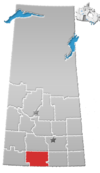|
Wood Mountain, Saskatchewan
Wood Mountain (2016 population: 20) is a village in the Canadian province of Saskatchewan within the Rural Municipality of Old Post No. 43 and Census Division No. 3. Its name is derived from the Red River Métis words "montagne de bois" (meaning mountain of wood in French), due to the abundance of poplar trees in the otherwise barren region. Highway 18 and Highway 358 intersect south of the community. Wood Mountain is known for its annual stampede that has been held every year for more than 124 years. This village is northeast of the First Nations administrative office for the band government of the Wood Mountain Lakota First Nation.[5] HistoryWood Mountain was the terminus of the Fort Ellice–Wood Mountain Trail that was used from 1757 to the 1850s to haul provisions such as pemmican by the Métis and First Nations. The trail was over 400 kilometres (250 mi) long.[6] It incorporated as a village on March 4, 1930.[7] Demographics In the 2021 Census of Population conducted by Statistics Canada, Wood Mountain had a population of 20 living in 8 of its 14 total private dwellings, a change of 0% from its 2016 population of 20. With a land area of 0.61 km2 (0.24 sq mi), it had a population density of 32.8/km2 (84.9/sq mi) in 2021.[10] In the 2016 Census of Population, the Village of Wood Mountain recorded a population of 20 living in 9 of its 10 total private dwellings, a -25% change from its 2011 population of 25. With a land area of 0.61 km2 (0.24 sq mi), it had a population density of 32.8/km2 (84.9/sq mi) in 2016.[11] Economy and tourism Historically, Wood Mountain's economy has relied mainly on the agriculture industry. The community still has strong roots to farming and ranching, but with its location and rich history, tourism has become a main industry. The region has accommodations, such as hotels and bed and breakfasts,[12] a cafe restaurant, outdoor pool, library, community hall, churches, museums, campgrounds, and parks. Local attractions
Events
Regional attractions
Notable residents
See alsoReferences
External linksWikimedia Commons has media related to Wood Mountain, Saskatchewan. |
||||||||||||||||||||||||||||||||||||||||||||||||||||||||



